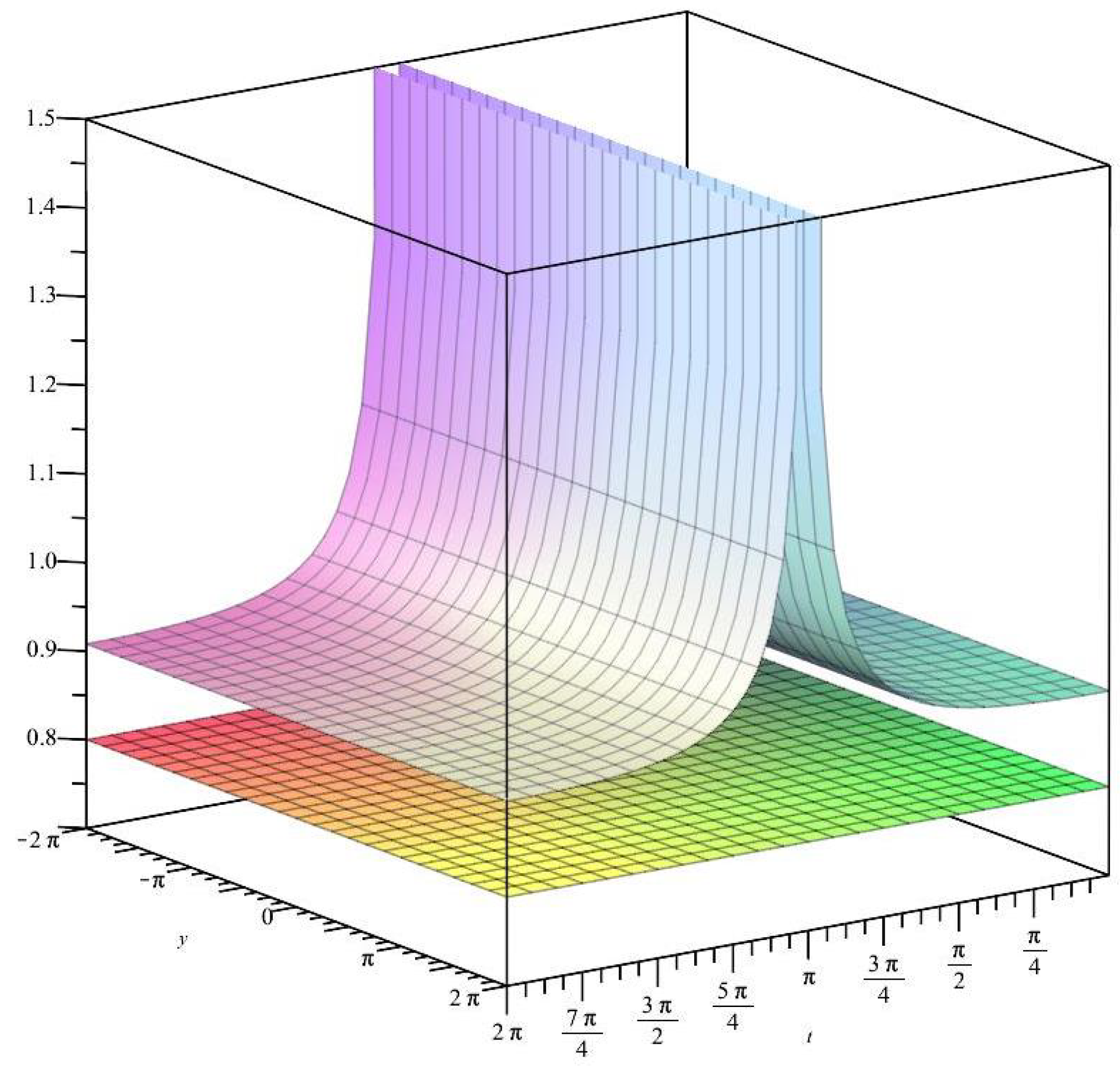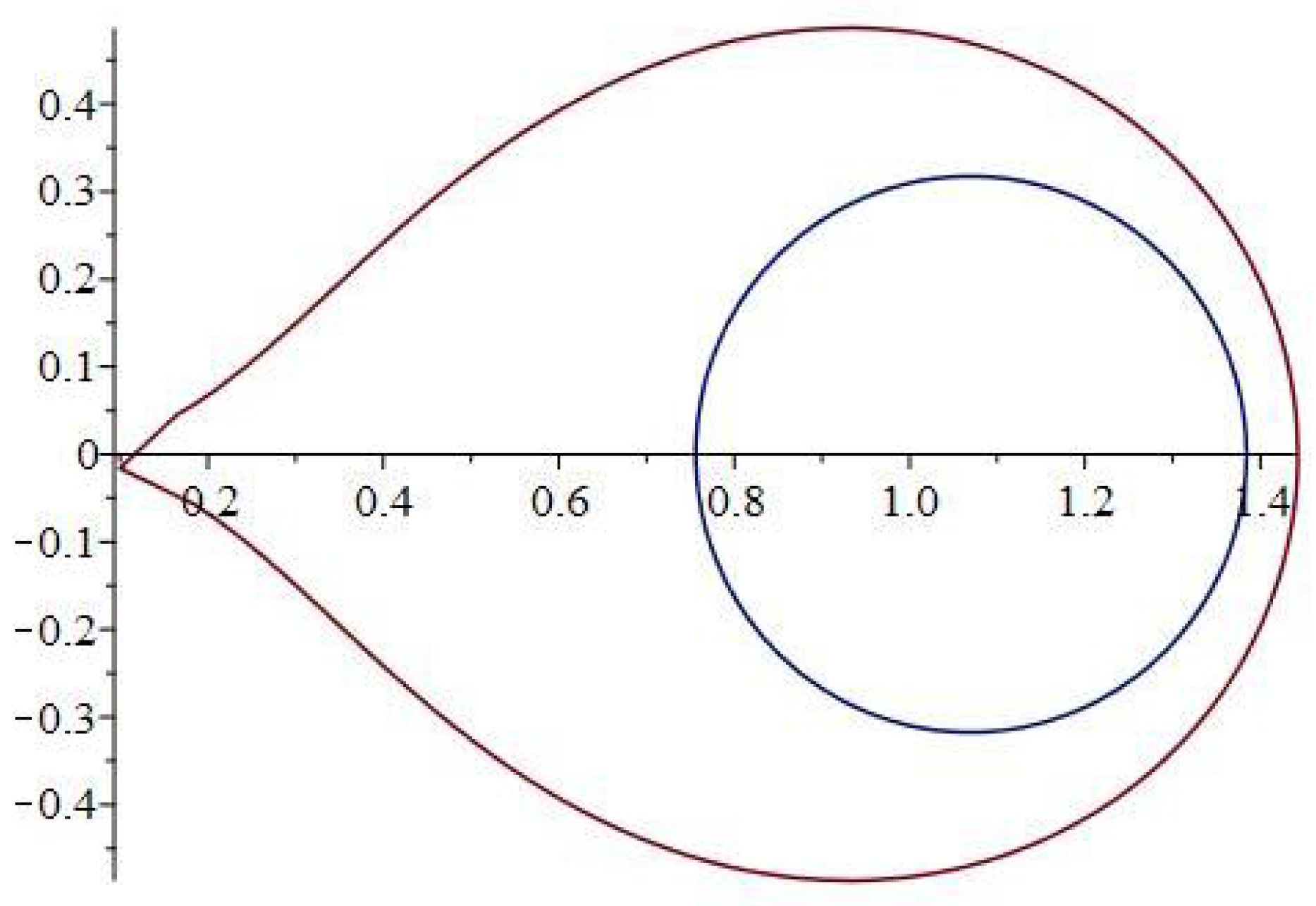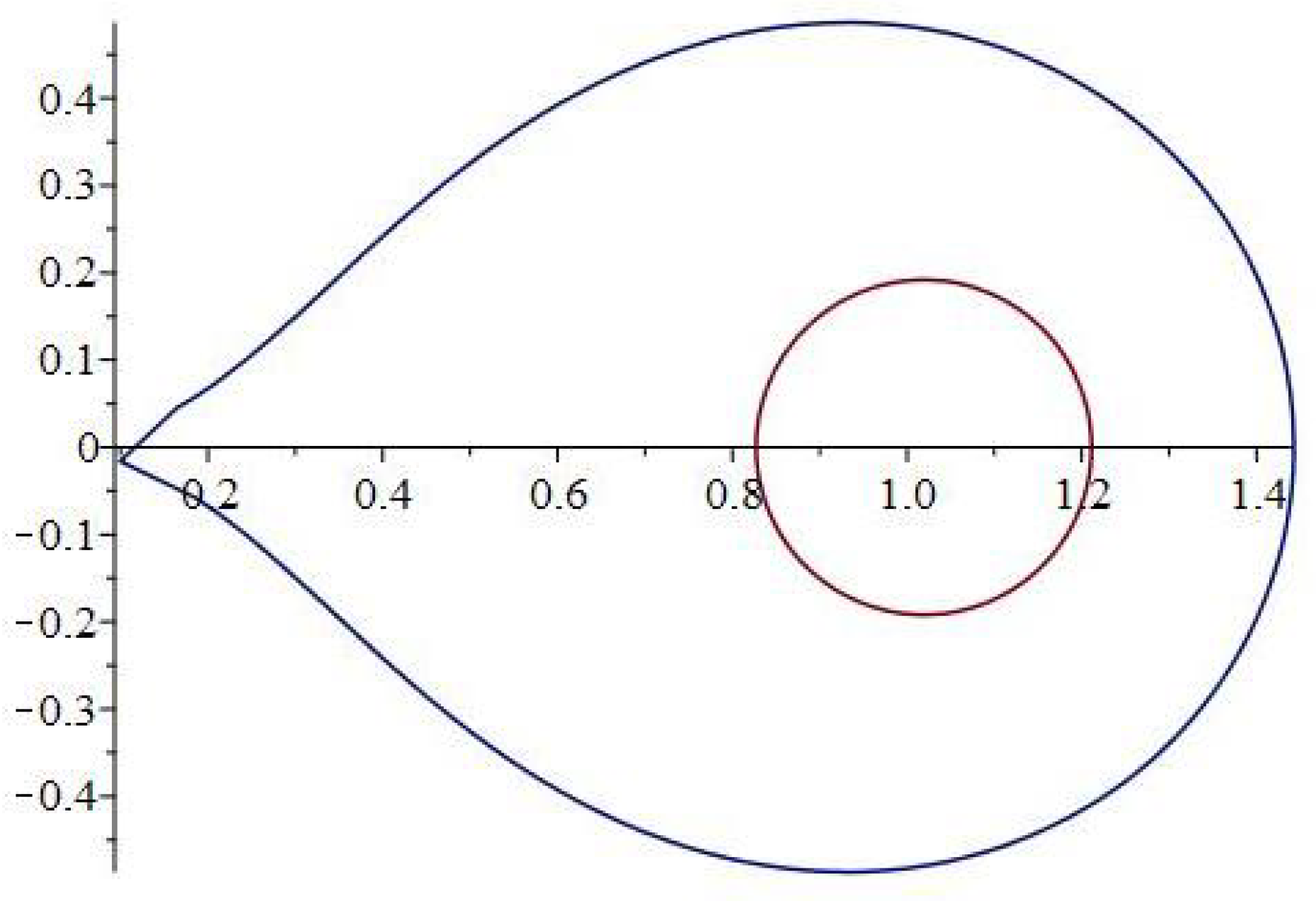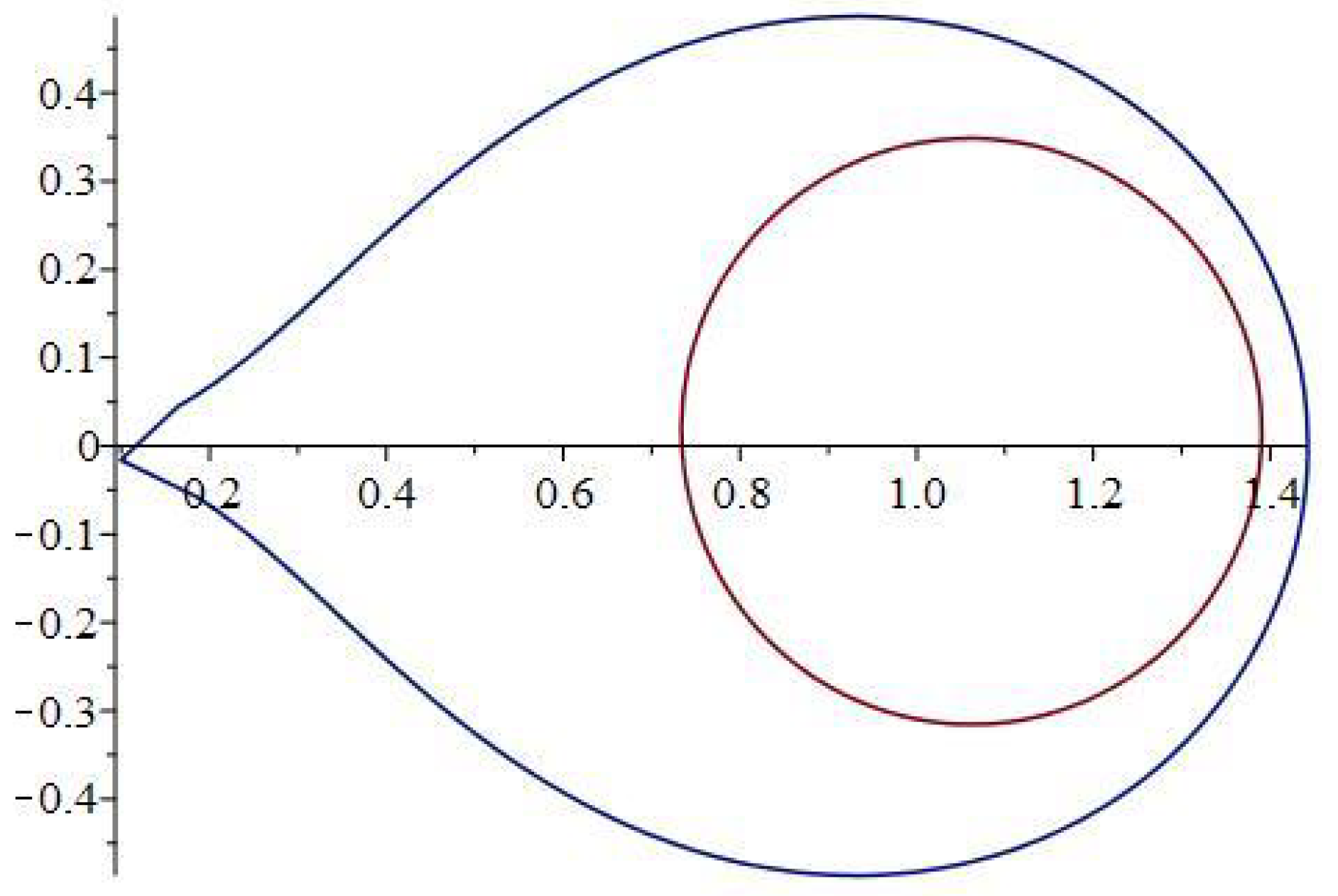1. Definitions and Preliminaries
Let
denote the class of all analytic (holomorphic) functions
f defined in the open unit disk
and normalized by the conditions
and
. Thus, each
has a Taylor–Maclaurin series expansion of the form
Further, let
denote the class of all functions
that are univalent in
. If
we say that
is subordinate to , written as
or
if there exists
, such that
,
. Moreover, if
is univalent in
, then, equivalently, we have
The Koebe one-quarter theorem confirms that the image of
under every univalent function
comprises a disk of radius
. Thus, every function
has an inverse
, defined by
and
Suppose that
has an analytic continuation to
. Then, the function
f is said to be bi-univalent in
if both
f and
are univalent in
and are represented by
Let
denote the class of bi-univalent functions defined in
The functions
are in
. However, the familiar Koebe function is not a member of
, while other common examples of analytic functions in
, such as
are also not members of
. Lewin [
1] examined the class
and found it to be
. Subsequently, Brannan and Clunie [
2] conjectured that
. On the other hand, Netanyahu [
3] showed that
. The problem of estimating the coefficient for each Taylor–Maclaurin coefficient
of
,
, is still considered an open problem.
Analogous to the familiar subclasses
and
of starlike and convex function of order
,
, respectively, Brannan and Taha [
4] (see also [
5]) introduced certain subclasses of
, namely the subclasses
and
of bi-starlike functions and of bi-convex functions of order
,
, respectively. For
and
, they found non-sharp estimates
and
of initial Taylor–Maclaurin coefficients. In fact, Srivastava et al. [
6] considered the study of analytic and bi-univalent functions in recent years for some intriguing examples of functions and characterization of the class
(see [
6,
7,
8,
9,
10,
11,
12,
13,
14]).
Fekete–Szegő functional
of
is well known due to its rich history of application in geometric function theory. Its origin is in the disproof of the hypothesis of Fekete and Szegő [
15] by Littlewood and Paley, finding that the coefficients of odd univalent functions are bounded by unity. Since then, this work has received great attention, especially for many subclasses of
. The problem of finding the sharp boundary of the
for any complex
is often referred to as the classical Fekete–Szegő problem (or inconsistencies).
Gregory coefficients . Gregory coefficients, also known as reciprocal logarithmic numbers, Bernoulli numbers of the second kind, or Cauchy numbers of the first kind, are the decreased rational numbers
. They occur in the Maclaurin series expansion of the reciprocal logarithm
These numbers are named after James Gregory, who introduced them in 1670 in the numerical integration context. They were later revived by many mathematicians and frequently appear in the works of modern authors, such as Laplace, Mascheroni, Fontana, Bessel, Clausen, Hermit, Pearson, and Fisher.
In this paper, we consider the generating function of the Gregory coefficients
(see [
16,
17]) to be given by
where
and the function log is considered at the main branch, i.e.,
. Clearly,
for some values of
are
To find the upper bound for the Taylor coefficients has been one of the critical topics of research in geometric characteristics, because it offers numerous properties for many subclasses of
. Therefore, we are interested in the subsequent problem in this section: find
if
for subclasses of
. In particular, the bound for
offers growth and distortion theorems for features of these subclasses. Further, the use of the Hankel determinant is relevant (which also deals with the bounds of the coefficients), and we also mention that Cantor [
18] proved that “if the ratio of two bounded analytic features in
, then the function is rational”. In this article, for the first time, we make an attempt to improve the initial non-sharp coefficients for certain subclasses of
.
2. Coefficient Bounds of the Class
In 2010, Srivastava et al. [
6] revived the study of analytic and bi-univalent functions. Inspired by this, in this section, we consider the class of analytic bi-univalent functions related to the generating functions of the Gregory coefficients to obtain initial coefficients
and
.
Definition 1. A function given by (1) is said to be in the class if the following subordinationsare satisfied, and the function is defined by (3). Remark 1. 1. For the function , we have , , and using the 3D plot
of the MAPLE™ computer software, we obtain that the image of the open unit disk by the functionis positive; hence, is a starlike (and also univalent) function with respect to the point 1 (see Figure 1). 2. We would like to emphasize that the class is not empty. Thus, if we consider , , then it is easy to check that , and, moreover, with .
Using the fact that for all , it follows that . For the particular case , using the 2D plot
of the MAPLE™ computer software, we obtain the image of the boundary by the functions , , and , shown in Figure 2. Since is univalent in , the previous explanation yields that the subordinations and hold whenever and (see Figure 2). In conclusion, ; hence, the class is not empty and contains other functions besides the identity. In our first results, we obtain better upper bounds for
and
for
given in Definition 1. Further, we use the following lemmas, which were introduced by Zaprawa in [
19,
20], and we discuss the Fekete–Szegő functional problems [
15].
Let , with , denote the class of analytic functions p in with and , . In particular, we use the notation instead of for the usual Carathéodory class of functions.
The next two lemmas are used in our study.
Lemma 1 ([
21])
. If has the form , , thenand this inequality is sharp for each . We mention that this inequality is the well-known result of the Carathéodory lemma [
21] (see also [
22], Corollary 2.3, p. 41, [
23], Carathéodory’s Lemma, p. 41).
The second lemma is a generalization of Lemma 6 from [
20], which can be obtained for
.
Lemma 2 ([
20], Lemma 7, p. 2)
. Let and . If and ; then, The following result gives the upper bounds for the first two coefficients of the functions that belong to .
Theorem 1. If is given by (1), then Proof. If
, from Definition 1, the subordinations (
4) and (5) hold. Then, there exists an analytic function
u in
with
and
,
, such that
and an analytic function
v in
with
and
,
, such that
Therefore, the function
belongs to the class
; hence,
and
The function
belongs to the class
; therefore,
and
From the equalities (
7) and (
8), we obtain that
and
Comparing the corresponding coefficients in (
11) and (
12), we obtain
From (
13) and (15), it follows that
and
If we add the equalities (14) and (16), we obtain
and removing the value of
from (
18) in (
19), we deduce that
Using (
6) together with the triangle inequality in the relations (
13) and (
20), it follows that
which proves our first result.
Moreover, if we subtract (16) from (14), we obtain
and in view of (
17), the equality (
21) becomes
The above relation combined with (
13) leads to
Using the triangle inequality and (
6), from (
23), we obtain
and using our first assertion together with (
22), it follows that
which completes the proof of our theorem. □
Using the above values for and , we prove the following Fekete–Szegő-type inequality for the functions of the class .
Theorem 2. If is given by (1), then, for any , the following inequality holds: Proof. If
has the form (
1), from (
20) and (
22), we obtain
where
From Lemma 1 we have
and also
. Then, in view of Lemma 2, we obtain
which is equivalent to our result. □
3. Coefficient Bounds for the Class
In the second set of results, we obtain the upper bounds for the modules of the first two coefficients for the functions that belong to the class defined below; then, we study the Fekete–Szegő functional problems for this function class.
Definition 2. A function given by (1) is said to be in the class if the following subordinations hold:where and is as in (3). By fixing or , we have the following special subclasses.
Remark 2. 1. For , let be the subclass of functions satisfyingwith . Fixing , let be the subclass of functions that satisfywhere . Remark 3. We prove that the appropriate choice of the parameter μ in the class is not empty. Letting , , it easily follows that , and, additionally, with .
With the notations of (24) and (25), simple computation shows that for all , which implies that . Taking the particular case and , using the 2D plot
of the MAPLE™ computer software, we obtain the image of the boundary by the functions Φ, Ψ, and , presented in Figure 3. Using the fact that is univalent in , the above explanation means that the subordinations and hold whenever and (see Figure 3). Therefore, ; hence, the class is not empty and contains other functions besides the identity. Theorem 3. If is given by (1), then Proof. If
has the form (
1), from Definition 2, for some analytic functions in
, namely
u and
v such that
and
,
for all
, we can write
and
From the equalities (
26) and (
27), combined with (
9) and (
10), we obtain
and
Equating the first coefficients of (
28) and (
29), we have
From (
30) and (32), it follows that
and
i.e.,
If we add (31) and (33), we obtain
and by substituting (
35) for
in (
37), we obtain
i.e.,
For the same reasons as in the proof of Theorem 1, using (
6) in (
30), (
36), and (
38), we find that
Simple computations shows that
whenever
; hence, we obtain our first inequality.
Moreover, if we subtract (31) from (33), we obtain
Using (
34) and (
36), the relation (
39) becomes
and using the triangle inequality together with (
6), we conclude that
Moreover, taking into the account the relation (
36), Formula (
40) could be rewritten as
and from the triangle inequality together with (
6), using the fact that
, it follows that
Since it is easy to check that
for
, our second inequality is proven. □
The next result gives an upper bound for the Fekete–Szegő functional for the class .
Theorem 4. If is given by (1), thenwhere Proof. If
, using the same notations as in the proof of the previous theorem, from (
38) and (
41), we obtain
where
is given by (
43). According to Lemma 2, from the inequality (
6), we obtain the conclusion (
42). □
For and , the above theorem reduces to the following two results, respectively.
Example 1. 1. If is given by (1), thenand 2. If is given by (1), thenand 4. Coefficient Bounds of the Class
In this section, we obtain the upper bounds for the modules of the first two coefficients for the functions that belong to the class that will be introduced, and we find an upper bound for the Fekete–Szegő functional for this class.
Definition 3. A function given by (1) is said to be in the class if the following subordinations are satisfied:where and is defined by (3). Remark 4. Note that by fixing , we obtain as was given in Example 2. For , we obtain the class .
Remark 5. We prove that for a suitable choice of the parameter λ, the class is not empty. Taking , , it can be easily shown that and with .
Using the notations of the Definition 3, it is easy to check that for all ; hence, . Taking the particular case , , and using the 2D plot
of the MAPLE™ computer software, we obtain the image of the boundary by the functions Θ, Λ, and , presented in Figure 4. Since the function is univalent in , the subordinations and hold because , and (see Figure 4). Hence, ; therefore, the class is not empty and contains other functions besides the identity. In the following theorem, we determine the results for the initial coefficient bounds of the class .
Theorem 5. If is given by (1), thenand Proof. If
, from Definition 3, there exist two analytic functions in
, namely
u and
v, such that
and
,
for all
, with
With the same notations as in the proof of Theorem 3, from the equalities (
44) and (45), we obtain that
and
Equating the corresponding coefficients in (
46) and (
47), we have
and
The relations (
48) and (
50) lead to
and
i.e.,
If we add (49) and (51), we obtain
and substituting the value of
from (
53) in the right-hand side of (
54), we deduce that
and thus
Using (
6) of Lemma 1 and the triangle inequality in (
53) and (
55), we obtain
which proves our first inequality.
If we subtract (51) from (49), we obtain
and in view of (
52) and (
53), the above relation leads to
Using again Lemma 1 and the triangle inequality, it follows that
Similarly, in view of (
55) and (
52), the relation (
56) could be written as
and from Lemma 1 and the triangle inequality, we conclude that
and this proves the second result. □
To determine the upper bound of the Fekete–Szegő functional for the class , we use the following lemma.
Lemma 3 ([
24], (3.9), (3.10) p. 254)
. If , with , then there exist some x, ζ with , , such that Theorem 6. If is given by (1), then Proof. If
has the form (
1), using (
52) and (
53), we have
. Thus, from (
55) and (
56), we obtain
With the same notations as in the proof of Theorem 3, from Lemma 3, we have
and
,
,
, and using (
52), we obtain
and thus
From the triangle inequality, taking
,
,
, and without losing generality, we can assume that
,
; thus, we obtain
Denoting
and
, the above relation can be rewritten in the form
Therefore,
and substituting the value
and
in the above equality, we obtain
Next we will determine the maximum of
H on
. Since
it is clear that
if and only if
. In this case, function
H is a decreasing function on
; therefore,
It is easy to check that
if and only if
; hence, the function
H is an increasing function on
, and consequently
and the estimation (
57) is proven. □











